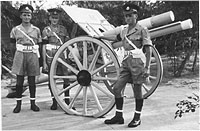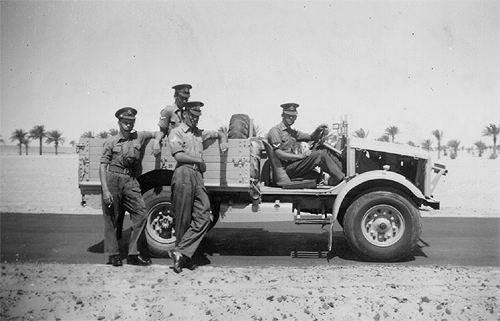


615 SPECIAL MOBILE PROVOST SECTION
"FATE"
As Remembered By Les Coulson
I joined the Army on 4-3-1954 as Rifleman at the Greenjackets Depot, Winchester and was selected for the Rifle Brigade, who after training would be posted to Malaya to confront the terrorist. After removing the light brown buttons on all the uniforms and sewing on black buttons – then removing all the green blanco on all the webbing and changing it to jungle yellow – we were quite proficient at scrubbing and sewing. Next was learning how to march round the square at 180 to the minute like mad men. We only left the depot once during the two weeks there and that was to post our civilian clothes home at the Post Office. After various types of jungle training, marching, running and the numerous injections we were issued with our own personal 303 rifle. Unfortunately I was issued with the one with the rusty barrel, which I’m sure is given to every intake so that an example can be made of someone. When the 2nd Lieutenant found the rust I was sent up to my barrack room, which was four floors up, to clean it. Having just a piece of string and a small square of cloth I made no impression. Two more trips and then the squad Corporal helped me with a wire brush fixed to a metal rod. Still very little improvement. The officer then ordered me to attend the guardroom at 18:00 hrs with full kit and rifle. During the day I was told to attend the PSO office and was asked why upon joining the army I wished to join the Royal Military Police? I explained that I intended to make the Metropolitan Police my career after leaving the Army. So I packed my kit and made my way to Woking to join the RMP. That was a close shave. I wonder if the 2nd Lieut. is still looking for me.
After 18 weeks training at the RMP depot, 17 of our squad of 19 were posted
to the Middle East. We flew out in an old Avro York aircraft which was only
semi pressurised and it took 13 hrs with a refuelling stop at Malta. We were
dressed in our serge battledress all the journey and when we arrived at Fayid
in the dark early hours on the 7th Sept 1954, we were pretty smelly. We were
taken to a transit camp nearby and left with our kit in a large tent with no
walls. The only things in the tent apart from sand on the floor, was metal frame
beds with dirty dusty old mattress’s on them. The first thing I noticed
was the heat and the thinness of the air. The smell of certain things were so
much stronger. Cigarette tobacco, latrines and the local natives! As it got
light, the road beside the transit camp got much busier with traffic and one
of the things that remains in my memory to this day is an Egyptian lorry laden
with barrels of waste food and sitting on top of them were half naked Egyptian
men eating the contents. During the morning we were taken to our unit, 203 Provost
Coy, RMP and our camp was situated at Ismailia, between the Sweet Water Canal
and Lake Timsah. Ismailia was ‘Out of Bounds’ to British service
personnel at the time and we patrolled the town in vehicles with one RMP and
one RAF Provost. We also provided foot patrols in Moascar garrison with one
RMP and one soldier from the unit posted to guard the garrison. We never patrolled
in pairs because there were insufficient RMP to do this. I also did motorcycle
patrols on the Canal Road to prevent any unauthorised use and speed limit enforcement.
This was a dangerous duty as there was always the fear of wires being stretched
across the road to decapitate motorcyclists.
|
|
|
|
When Ismailia was opened up for service personnel to visit, we opened an Information
Post in French Square. I was on duty there one day when two soldiers came in.
One said that he had had his army beret snatched from his head by an Egyptian
photographer in the square and refused to give it back until the soldier had
paid for the photograph he had taken. He refused to buy it because of the poor
quality. I locked the Information Post and drove round the square with the two
soldiers in their Standard Pick Up vehicle. I was seated beside the driver with
the other soldier kneeling in the back behind us. I noticed a sten gun between
the two front seats and, as I was unarmed, I loaded the weapon and placed the
mechanism in the safety position. I handed the weapon to the soldier in the
back and told him to watch out for us. The driver and I approached the photographer
and after looking at the picture he had taken, told him it was “Mush Quiess”
(No Good). I retrieved the drivers beret which was on the photographers tripod,
when there was a loud crack behind us coming from the Pick-up truck. We saw
a puff of smoke coming out of the open window of the vehicles nearside door.
On our return we found that the soldier inside had fired a round from the weapon
into the inside of the door, breaking the glass inside. I took charge of the
weapon because it had jammed and was in the automatic position. On returning
to the Info Post I attempted to unload the sten gun but could not hold it and
remove the ammunition magazine at the same time because it was jammed so tight.
I therefore took a firm hold of the gun with both hands and got the driver to
pull on the magazine to remove it. This we did, but in doing so, 3 or 4 rounds
were fired into the wall. We were in the small prisoners cell at the back of
the Info Post, which was fully tiled from floor to ceiling and I was amazed
at the small amount of damage caused by the impact of these rounds. The sten
gun is a very unstable weapon and had resulted in many accidents. Fortunately
on this occasion nobody was injured.
|
|
|
A few days later I was on OC’s orders and marched in by the RSM and expected that I was in trouble. He said the commanding officer of the two soldiers I had helped in Ismailia had asked him to thank me for the action I had taken. I sighed a sigh of relief. ‘Fate’ again.
Now we all know – “Never volunteer for anything in the army”.
But when the CO asked if I would like to help protect the GOC Lt General Hull
and join 615 SMPS, I couldn’t resist. 615 Special Mobile Provost Section
was armed vehicle protection for Gen. Hull when he travelled around the Canal
Zone. In the section we had 1 Sgt, 2 Cpl’s and 12 L/Cpl’s. we travelled
in two Land Rovers, one in front and one behind the Generals Humber Pullman.
We were three up in each vehicle with Bren guns, Sten or Sterling sub machine
guns, .38 revolvers and smoke grenades. The vehicles were stripped of windscreens,
spare tyres and rear canopy for maximum speed. We sat on foam cushions and wore
soft peaked caps. Seat belts and air bags hadn’t been invented. We travelled
between 70 and 80 MPH on the good roads and must have been mad. Certainly killed
if we had crashed.
 |
 |
 |
Whilst stationed at 615 SMPS we were billeted next to General Hulls house where he lived with his family and staff. His young son, William Amyad, used to join us on gate sometimes and when the General returned home by car and escort, we would salute and so did his son. Young William (aka Bill) loved to come round to see us and join in anything we were doing – cleaning and bulling vehicles, football, playing soldiers, posing for photos etc.
|
|
Young William posing with friends for phoygraphs |
It was good to see the pictures of the GOC Staff and Military Police Escort in the August Issue of The Canal Zoners. It got me thinking of when I was posted there. I remember Cpl Roy Heslop (1st left, bottom row in the picture). He taught a number of us to drive but he couldn’t swim. So I bet him that it was easier to swim than drive, which he disputed. However, he did teach us to drive and I taught him to swim. I don’t think he ever paid me! We used to go to French Beach to do our swimming and our learner driving was in an old Bedford 15 cwt. (pictured here)

Myself & Roy standing with others learning to drive in theBedford 15 cwt
This painting was on the wall in the Mess Room at 203 Provost Company. It was painted by L/Cpl Sutherland and shows a Military Police Mobile Patrol

In initial training I hated the taste of the porridge. But after a couple of months in Egypt I tried it again and it tasted so good. I asked the cook for some more and asked him what were the black bits he put in to make it taste so good. He said “I don’t put them in – they’re WEEVILS”
|
John Gaunt, Roy & Myself at French Beach |
|